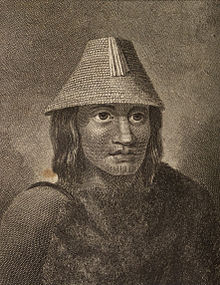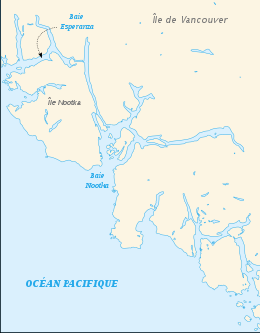Nootka Sound
| Nootka Sound | |
|---|---|
| French: Baie de Nootka | |
| Mowichat (Nuu-chah-nulth) | |
 Clouds over Nootka Sound | |
Map of Nootka Sound | |
| Location | Vancouver Island, British Columbia |
| Coordinates | 49°41′N 126°33′W / 49.683°N 126.550°W |
| Type | Sound |
| Ocean/sea sources | Pacific Ocean |
| Settlements | Gold River, Tahsis, Yuquot, Zeballos |
Nootka Sound (French: Baie de Nootka) is a sound of the Pacific Ocean on the rugged west coast of Vancouver Island, in the Pacific Northwest, historically known as King George's Sound. It separates Vancouver Island and Nootka Island,[1] part of the Canadian province of British Columbia. It played a historically important role in the maritime fur trade.
History



The inlet is part of the traditional territory of the indigenous
European exploration and trade
On August 8, 1774, the
In March 1778, Captain
At the time, the Spanish monopolized the trade between
The next European to visit Nootka Sound after James Cook was the British trader
In 1786 another maritime fur trader, James Strange, visited Nootka Sound. One of his crew, John Mackay, volunteered to remain at Nootka and work to establish relationships until Strange returned the next year. But Strange never returned. When the trader Charles Barkley arrived at Nootka in the summer of 1787, he was surprised to find John Mackay who, over the year, had learned the Nuu-chah-nulth's language and customs, adapted himself to their ways, and married a young native girl.[8] At first Mackay was welcomed and befriended by Maquinna, but after unknowingly breaking a taboo he was exiled from Maquinna's house and forced to survive on his own. Barkley took Mackay on board his ship, Imperial Eagle.[9]
Nootka Crisis
Starting in 1774 Spain sent
The Nootka Sound controversy also played a part in the
Thomas Muir
The Scottish political reformer
In conversation with José Tovar, the piloto (master) of Sutil, a Spanish vessel at anchor in the Nootka Sound, Muir learned to his dismay of the presence in neighbouring waters of HMS Providence, the British sloop-of-war under William Robert Broughton. This vessel had visited Port Jackson in Australia shortly before Muir’s escape and, since Broughton had almost certainly become acquainted with the captain or members of the crew, his life was now in real danger.
To be captured while under sentence of transportation meant immediate execution. Once again Muir’s extraordinary luck held out. While a student at Glasgow, he had acquired a fluent command of Spanish and he was now able to persuade Tovar to break his regulations regarding the admission of foreigners into Spanish territory. Changing vessels he sailed with Tovar down the
The chronicles of Pierre François Péron describe Muir's escape from Australia and the voyage across the Pacific to Nootka Sound, and then as far as Monterey, California.
Nootka Sound has not been the scene of any major international disagreements in modern history.[11][13]
Climate
| Climate data for Nootka Lightstation | |||||||||||||
|---|---|---|---|---|---|---|---|---|---|---|---|---|---|
| Month | Jan | Feb | Mar | Apr | May | Jun | Jul | Aug | Sep | Oct | Nov | Dec | Year |
| Record high °C (°F) | 18.5 (65.3) |
16.5 (61.7) |
18.5 (65.3) |
23 (73) |
27.5 (81.5) |
30 (86) |
32 (90) |
30.5 (86.9) |
26.5 (79.7) |
22.5 (72.5) |
22.5 (72.5) |
18 (64) |
32 (90) |
| Mean daily maximum °C (°F) | 7 (45) |
8 (46) |
10 (50) |
12 (54) |
14.7 (58.5) |
16.7 (62.1) |
19.1 (66.4) |
19.5 (67.1) |
17.8 (64.0) |
13.3 (55.9) |
9.1 (48.4) |
7 (45) |
12.9 (55.2) |
| Mean daily minimum °C (°F) | 3.3 (37.9) |
3.5 (38.3) |
4.2 (39.6) |
5.6 (42.1) |
8.2 (46.8) |
10.4 (50.7) |
12.3 (54.1) |
12.9 (55.2) |
11.6 (52.9) |
8.4 (47.1) |
5.1 (41.2) |
3.3 (37.9) |
7.4 (45.3) |
| Record low °C (°F) | −6.5 (20.3) |
−10 (14) |
−2.5 (27.5) |
0 (32) |
1 (34) |
5 (41) |
6 (43) |
9 (48) |
5 (41) |
−1 (30) |
−7 (19) |
−5.5 (22.1) |
−10 (14) |
| Average precipitation mm (inches) | 438.1 (17.25) |
363 (14.3) |
299 (11.8) |
264.1 (10.40) |
164.6 (6.48) |
159.2 (6.27) |
78 (3.1) |
91.7 (3.61) |
152 (6.0) |
348.4 (13.72) |
459.3 (18.08) |
456.3 (17.96) |
3,273.6 (128.88) |
| Source: Environment Canada[14]
| |||||||||||||
Luna the orca
In 2001, a two-year-old male
In popular culture
It is mentioned in the former unofficial national anthem of English-speaking Canada, "The Maple Leaf Forever", to represent the western extent of Canada's "fair dominion".
Nootka Sound is referred to in the 2017
See also
- Nootka Convention
- History of the west coast of North America
- Spanish expeditions to the Pacific Northwest
- Vancouver Expedition
- Bligh Island Marine Provincial Park
References
- ^ "Port Cox". BC Geographical Names.
- ISBN 0-7734-8857-X.
- ISBN 0-88894-279-6.
- ISBN 978-0-7748-1367-9.
- ^ Alexander von Humboldt, Political Essay on the Kingdom of New Spain, translated by John Black, Vol. 2, London, Longman, 1822, translator’s note, p.322.
- ISBN 0-88894-279-6.
- ISBN 0-88894-279-6.
- ISBN 978-0-88894-056-8. Retrieved 3 May 2020.
- ISBN 978-1-55017-682-7. Retrieved 6 May 2020.
- ^ Robert J. King, "'The long wish'd for object' — Opening the trade to Japan, 1785–1795", The Northern Mariner, vol.XX, no.1, January 2010, pp.1–35.
- ^ a b "The Nootka Incident". Canadian Military History Gateway. 2005. Archived from the original on October 18, 2006. Retrieved 2005-03-25.
- ^ Robert J. King, “George Vancouver and the contemplated settlement at Nootka Sound”, The Great Circle, vol.32, no.1, 2010, pp.3–30.
- ^ "Timeline of Nanaimo (PDF)" (PDF). City of Nanaimo. 2004. Archived from the original (PDF) on 2007-10-08. Retrieved 2007-03-09.
- Environment Canada—Canadian Climate Normals 1971–2000, accessed 12 August 2012
- ^ a b c Parfit, Michael (November 2004). "Whale of a Tale". Smithsonian Magazine. Retrieved 17 September 2019.
- ^ "Luna killed by tugboat". CBC News - British Columbia. 10 March 2006. Retrieved 17 September 2019.
- ^ Suzanne Chisholm; Mike Chisholm (March 11, 2006). "Luna (L98) – Nootka Sound's friendly orca: A true tale of a legendary whale (includes 24 minute documentary video)". Gold River Chamber of Commerce. Retrieved 17 September 2019.
Bibliography
- Harboard, Heather. Nootka Sound and the Surrounding Waters of Maquinna. Surrey: Heritage House Publishing Company Limited, 1996. ISBN 1-895811-03-1.
- Jones, Laurie. Nootka Sound Explored. Campbell River: Ptarmigan Press, 1991. ISBN 0-919537-24-3.
- Manning, William Ray. The Nootka Sound Controversy. Part XVI of the Annual Report of the American Historical Association for the Year 1904, Washington: Government Printing Office, 1905, pp. 279–478. Reprint: Ann Arbor: University Microfilms Inc., 1966.
- Jewitt, John Rodgers (1896). The adventures of John Jewitt: only survivor of the crew of the ship, Boston, during a captivity of nearly three years among the Indians of Nootka Sound in Vancouver Island. Clement Wilson.Available online through the Washington State Library's Classics in Washington History collection
- King, Robert J. "'A regular and reciprocal System of Commerce' — Botany Bay, Nootka Sound, and the isles of Japan", The Great Circle (Journal of the Australian Association for Maritime History) vol.19, no.1, 1997, pp. 1–29.
- King, Robert J. "William Bolts and the Austrian Origins of the Lapérouse Expedition", Terrae Incognitae, vol.40, 2008, pp. 1–28; presented at the Canadian Nautical Research Society Conference, Churchill, Manitoba, 2–7 August 2007.



